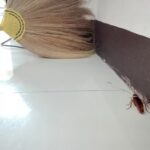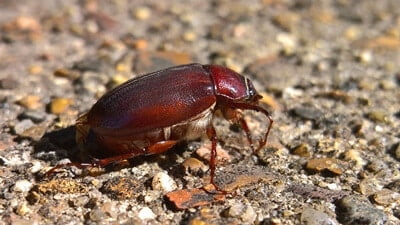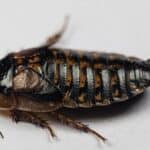Roaches are good at hiding in many places around the home. If you don’t know where to look, cockroaches will quickly breed and multiply. Certain areas of the home are at greater risk than others of harboring roaches.
Cockroaches hide in room corners, walls, moldings, light fixtures, and baseboards. They may also take up residence behind fridges, dishwashers, microwaves, ovens, and other electrical appliances. In your bedroom, roaches prefer your drawers and closets. Bathrooms may harbor roaches in drains, pipes, and cabinets.
Cockroaches hide wherever they can find seclusion, darkness, and heat. If these areas also have food and water, they will reside in that area. That means that your kitchen and bathroom are at the most risk of an infestation. Your living room and bedrooms are acceptable places to hide if roaches can’t find anywhere better.
Where Do Roaches Hide In Your Room?
Not all roaches will choose the same hiding space because different species have preferences for food, shelter, and reproductive security. While no roach can resist an open container of food, others may prefer to live in:
- Humid environments, such as a basement
- Electronics, such as those found in your living room
- Pantries, where they have food and opportunities to chew through food packaging
If you know what kind of roach you’re dealing with, this helps narrow down where roaches are nesting. Of more than 4,500 roach species in the world, only 4 are considered common household pests. If you see one of these kinds scurrying around your home, take a moment to note its:
- Size
- Coloring
- Wings
- How they move
This will enable you to determine which species of cockroach has taken root in your home. With that information on hand, you can deduce where to find the others.
Where American Cockroaches Hide
The American cockroach is characterized by its large size (1.6 inches), reddish hue, and fully-formed wings.
The American cockroach is likely to fly and scurry around to satisfy its cravings. It’s also one of the fastest reproducers, so a colony will quickly grow in size. You’ll normally find them in:
- Kitchens and bathrooms
- Behind electrical appliances
- Garbage disposal units
- Sewers, pipes, and drains
- Room corners
- Basements
Where Oriental Cockroaches Hide
Oriental cockroaches are one inch long, oval, wingless, and a deep brown or red color. They may appear black in some lighting conditions. They’re less dexterous and move more slowly than other species.
Their most notable trait is their love of water. Outdoors, you will find them near ponds and other sources of stagnant water. Barring that, these roaches will seek out damp and humid areas with high levels of moisture. This includes:
- Basements, especially if there has been flooding
- Crawl spaces
- Inside pipes and drains
- Bathrooms
- Outside the home (leaf piles, mulch, firewood, etc.)
Where German Cockroaches Hide
German cockroaches are brown to dark brown in color, with parallel bands running along the length of their bodies. Their most notable characteristic is their small size, sometimes less than half an inch in length, making them difficult to find. German cockroaches can slip through small cracks and crevices. Favored places include:
- Kitchen appliances, cabinets, and underneath sinks
- Behind appliances, such as refrigerators and microwaves
- Bathroom pipes and drains
- Baseboards and trims
- Room corners
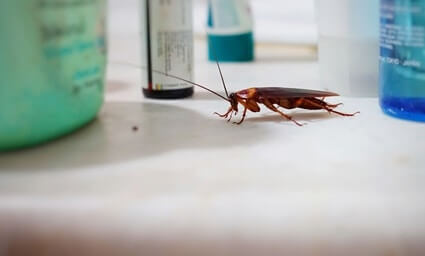
Where Do Roaches Live In Your House?
Roaches will hide anywhere that enables them to avoid detection. There is no one place in your home that will be inhospitable to cockroaches, but they will choose areas that have:
- Ample food
- Little activity
- Warmth
- Water or moisture
If all these factors aren’t available at one location, roaches will make adjustments. They may accomplish this by making supply runs to different areas of your home. For example, if there’s moisture in your bathroom but no food, roaches may scurry towards a food scent that they detect in the kitchen or pantry.
Cockroaches can survive for a surprising amount of time without all of the things that they need. According to The Journal of Economic Entomology, American cockroaches survived for long stretches without food and water. Madeira cockroaches survived for more than 50 days.
Where Do Roaches Hide In Bedrooms?
It’s harrowing to think of roaches crawling around the room or roaches crawling on you as you sleep. These pests can trigger allergies, asthma and spread harmful bacteria on surfaces that they touch.
Storage Spaces
If you have a disorganized home, the bedroom can become a secondary storage area. Clothes, trinkets, and gifts can all accumulate in your sleeping area, attracting pests. Storage bins and crates attract roaches for these reasons:
- Storage boxes are rarely opened, providing a dark, quiet place to hide.
- Boxes are often stacked in a corner and left undisturbed, so roaches can come and go without being noticed.
- Boxes can be made from (or filled with) paper, cardboard, and tissues. These are food sources for roaches.
- Boxes may be transferred to bedrooms from infested areas, like the garage or a neighbor with a roach problem.
- Roach egg sacs can be laid on boxes and overlooked as you pack or move them.
Closets, Dressers, And Drawers
Roaches will live in places where clothes are stored. This may include:
- Closets
- Dressers
- Wardrobes
- Drawers
Roaches find these to be ideal places to live, since they’re:
- Dark. Certain drawers or areas of your closet may hardly ever see the light.
- Quiet. You’ll only use your closet once or twice a day.
- Warm. If you have clothes packed into a drawer or dresser, roaches can nest in the warm layers.
- Compartments. Perhaps you never look at the back of your dresser drawers. These are ideal spots to lay eggs.
Do Roaches Hide In Clothes?
Roaches aren’t well-known for living inside clothes. However, they will take the chance if they have no other options. After all, clothes are often stored in drawers and closets. Clothing offers the following benefits:
- Certain fabrics are edible. Cotton contains fiber and proteins that a roach can survive on for a while.
- Fabrics are warm. The layers of your clothes will be warm.
- A good place to hide eggs. Clothing is a safe, quiet area to conceal eggs.
Even if the cockroaches don’t nest on the clothing, they’re likely to crawl on it. This can leave behind trace bacteria, feces, and fungi, so you’ll be exposed to these contagents. You may also give away clothing or store it in different areas, allowing the planted egg sacs to hatch and spread the infestation.
Check over and wash your clothes regularly. That’s especially true if it’s been stored in the back of your closet for a while. If you notice any of these signs, be sure to take action:
- Egg cases
- Stains
- Exoskeletons
- Poop
If you want to protect your clothing, consider mothballs. Not only will these keep out moths, but these poisons will also deter roaches.
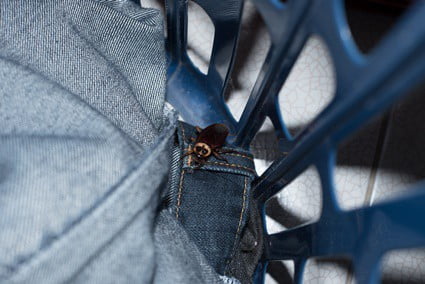
Do Roaches Hide In Mattresses?
Roaches are capable of hiding anywhere. Your mattress may be a target if:
- There are no other hiding places
- There’s no access to other types of food
- There are gaps or rips in the sides of your mattress
- The home is cold, especially at night
From here, they have access to many appealing things:
- Warmth
- Fabric to eat
- Quiet shelter during the day and night
- Darkness
- Humans
A hungry cockroach may be tempted to scour your bed for food. This will include skin cells and hair, which can sustain a roach for a short time. If the insect grows desperate, it may even start chewing on you as you sleep.
Where Do Roaches Hide In The Bathroom?
When it comes to places well-loved by cockroaches, bathrooms are a top contender. These locations have everything a roach could need. They’re:
- Quiet, especially at night
- Dark, with limited natural lighting
- Humid, especially after a steamy shower
- Have ample water in the shower, toilet, and sinks
- Have organic waste in the form of hair, skin cells, and sanitary products
- Have plenty of hiding spaces
Drainage Pipes
Roaches can enter via certain drains from the sewer. They may scuttle up the metal and gain access to your home. Be sure to check over:
- Shower drains
- Bathtub drains
- Sink drains
The majority of modern homes have plumbing designed to prevent access. More than likely, the roaches came into your home through a different access point. Once inside, they’ve found their way into your bathroom and settled in your drains. These spots provide an ideal hiding place because they’re:
- Dark
- Humid
- Collect hair, skin cells, toothpaste, and grime
- Rarely cleaned
Roaches aren’t good swimmers and can’t fight against a strong flow of water. If you have one sink or a tub that sees little use, these drains will be at most risk. Roaches may crawl in and out at will, eating what they find in other drains.
Cabinets
The items stored in cabinets are edible to cockroaches. As such, these areas are not only dark, quiet, and secure, they’re also feeding areas. Cockroaches may nest, lay eggs, and get their dinner in one spot, consuming:
- Toothpaste
- Soap (contains animal fats and oils)
- Tissue and toilet paper (cellulose in the fibers)
False cabinets that hide pipes are also a prime location. Roaches that come through pipes can easily make the cabinets their home. These spots don’t store anything, so they see even less activity than other cabinets. They provide a direct source of water and easy access to other areas for food.
Trim And Molding
Bathrooms often have their floors and ceilings lined with trim or molding. Even when left perfectly flush against the wall, cockroaches can still gain entry to these tiny spaces. According to an article published in International Pest Control, full-grown American cockroaches have been known to squeeze in spaces as small as 3 mm.
Steam and humidity may have caused the trim or molding to swell. It’s also possible that previous water damage has caused gaps to form along your walls. These areas may eventually lead to rotting wood. Roaches, especially American cockroaches, like eating wood that has already been softened.
Where Do Roaches Live In Kitchens?
Kitchens provide easy access to food and water, as well as having many hiding spaces. These include:
Fridges
Roaches may gain access to the inside of a fridge by:
- Sneaking in while the door is open
- Hitching a ride on the outside of food containers
- Burrowing in through a small gap in the shell or lining
Once inside, they can spread bacteria to food. When looking for a nest, the main issues will be the:
- Back of the fridge
- The underside of the fridge
- The outer insulation
Here, the cockroaches can find a perfect habitat. They can benefit from the:
- Warmth of the motor
- Darkness and seclusion
- Access to the pantry and countertops
- Leaks or condensation in the fridge.
- Ease of access to other areas, such as cabinets and the sides of the fridge
Dishwashers
Dishwashers lead to moisture, especially those that aren’t regularly cleaned. Stagnant water is a common attractant for roaches, and dishwashers have a lot of it.
Dirty dishes left overnight can attract roaches, as well as food stuck in the drain. Roaches may use the dishwasher as their main feeding zone, while hiding elsewhere. If they decided to nestle in the machine itself, they’ll do so:
- Underneath it
- In any gap between it and the wall or cabinets
- In and around the hoses that extend from the back
To prevent roaches from entering your dishwasher, you should:
- Run your machine as soon as you load it with dishes
- Clean the machine to remove food after the wash cycle
- Remove any sources of stagnant water
- Clean it with bleach once a month to remove tempting smells
Stoves And Ovens
Roaches can live in stoves and ovens, despite the heat. If the temperatures climb too high, they’ll escape into the surrounding cabinets. They may also nestle in less hot areas. Ovens and stoves are good spots because they:
- See little activity, as you won’t often move or check behind the machine
- Have storage compartments for pans, where roaches can hide or lay eggs
- Stay warm, meaning that roaches can remain comfortable and safe
- Are full of food scraps, such as leftover crumbs from a pizza in the oven or sauces on the stovetop
Pull out your oven once every month and check behind it. Not only will this help you find and prevent roaches, but other pests as well. Cleaning up dust, crumbs, and grime will keep the area less appealing to insects.
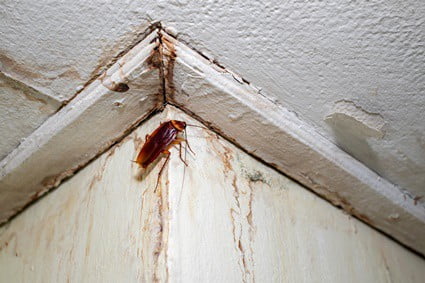
Microwaves
Roaches can live in microwaves because of dead spots in the microwave’s radiation. Not all areas will be exposed, even when the machine is in use. A cockroach may:
- Nestle in the back of it
- Slip into the wiring
- Use it for cover while it nests against a wall.
In some circumstances, dismantling the microwave is the best option for removing cockroaches. This will ensure that no nymphs are living in crevices. Likewise, this will also expose any eggs that may be hiding in small gaps.
Do Cockroaches Hide In Walls?
Walls are usually an access point into your home for a roach. They may have cracks and crevices that can be manipulated. Once inside the walls, a cockroach will eat through the insulation. This allows them to form nests, lay eggs, or enjoy an ample food source.
Gaps between conduits, like electrical outlets and light fixtures, are also common entry points. You may find roaches using the insides of your walls as a highway around your home.
Do Cockroaches Live In Ceilings?
Cockroaches may make a nest or gain entry through:
- Gaps around ceiling fans or lights
- Cracks along the ceiling
- Gaps in the detailing of crown molding
Do Roaches Hide In Furniture?
Living room furniture can be a quick, easy hiding spot for roaches. In fact, if you’ve purchased a sofa or chair second-hand and now suddenly have roaches, guess what? That item is probably how the roaches gained entry to your home.
Roaches can eat furniture parts of furniture, such as fabric. However, they prefer to consume leftover food, crumbs, and spills. If you let a potato chip between the cushions, a nearby cockroach will find it.
Couches
If you’ve ever lost the remote control, you’ll know that there are many nooks and crannies within a couch. Roaches often utilize these gaps to make a home. Here, they can lay eggs and make nests:
- Underneath the cushions
- In the bottom lining of the sofa
- In between the springs inside the couch
- In the arms, if the roaches burrowed through the lining
On top of that, materials and fabrics that make up sofas or couches are edible to roaches. They’ll eat leather, cotton, suede, and various other fabrics.
Cockroaches will eat any spilled dip, dropped chips, or spare popcorn you’ve left behind. They are the most attracted to sugary or fragrant drinks. Cockroaches have an excellent sense of smell. Even if you think that you’ve cleaned up a stain relatively well, the chances are that a roach noticed.
Wooden Furniture
In the wild, some roaches live in wood. While their mandibles are not powerful enough to chew through solid wood, softer kinds will be appealing. This may include thin detailing or wood that’s suffered from recent water damage. Old wood that’s beginning to splinter or give off shavings can be a food source for a cockroach.
Do Roaches Hide In Electronics?
Electronics are a favored place for cockroaches to hide in a home, especially:
- Power strips
- TVs
- Gaming consoles
- Kitchen appliances
- Wiring
- Sewing machines
- Lamps
Electronics are dark and remain placed in one spot for long periods of time. More than anything, electronics give off heat. This makes it attractive to roaches, especially if the rest of the house is cold. Here, they may not directly chew on the devices, but they’ll lay eggs, poop, and shed skin. This can damage your electronics.
Knowing where roaches hide and getting rid of them is only half of the battle. Making sure that roaches don’t come back is just as important. To avoid roach infestations, seal up any entrances from the outside.

